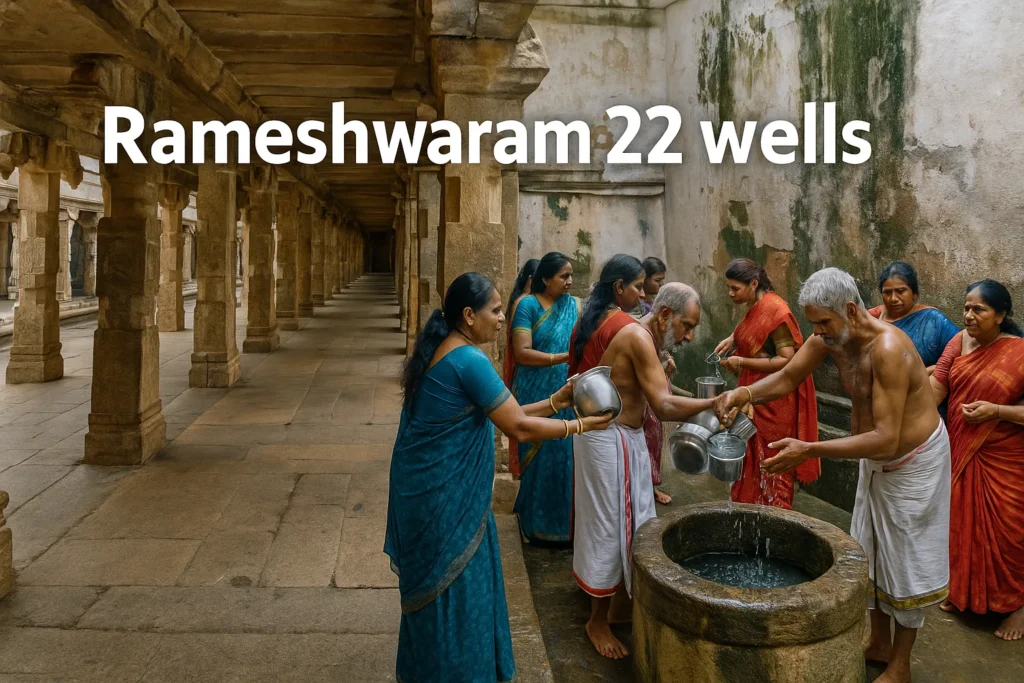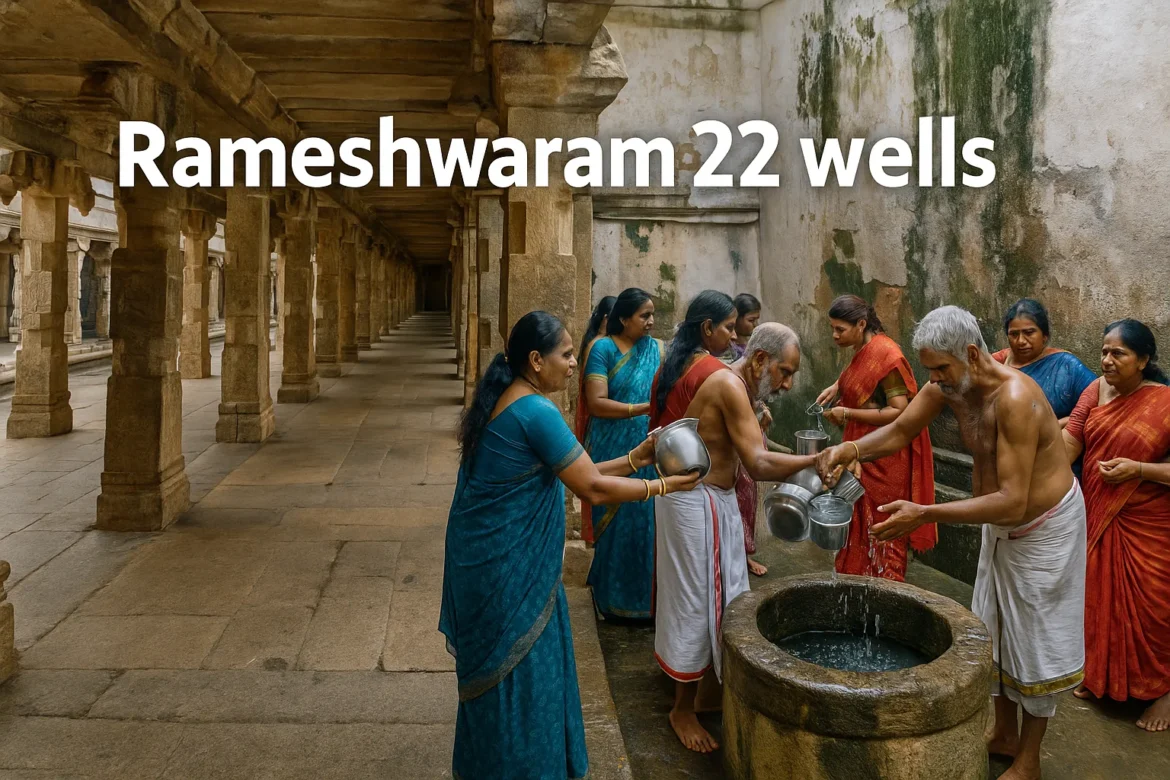Complete guide to Rameshwaram’s 22 sacred wells bath timings (5:30 AM-12 PM, 3:30-6 PM), rituals, spiritual significance & online booking. Expert tips for your transformative pilgrimage to Ramanathaswamy Temple’s holy Theerthams.
The moment I stepped into the sacred corridors of the Ramanathaswamy Temple in Rameshwaram, I felt an overwhelming sense of spiritual energy that seemed to emanate from the very stones beneath my feet. Having visited numerous temples across India, nothing had prepared me for the profound experience of bathing in the 22 sacred wells, known as Theerthams, that lie within this ancient temple complex. This comprehensive guide shares my personal experience and provides you with everything you need to know about these mystical wells, their timings, rituals, and the life-changing spiritual journey they offer.

Understanding the Sacred 22 Wells (Theerthams) of Rameshwaram Temple
The 22 sacred wells within the Ramanathaswamy Temple are not merely architectural marvels; they represent a spiritual odyssey that has been undertaken by millions of devotees for over a millennium. According to tradition, the lingam (an aniconic form of Shiva) of the Ramanathaswamy Temple was established and worshipped by Rama before he crossed the bridge called Rama Setu to the island kingdom of Lanka, making this one of the holiest sites in Hinduism.
Each of these wells, or Theerthams, holds a unique spiritual significance and is believed to possess divine healing properties. The number 22 indicates the 22 arrows in Rama’s quiver, symbolizing the connection between Lord Rama’s divine mission and the spiritual purification offered to devotees today.
My Personal Journey: The Transformative Experience of 23 Sacred Baths
My spiritual journey in Rameshwaram began at dawn, following the traditional sequence that has remained unchanged for centuries. The experience starts with a holy dip in the Agni Theertham at the seashore, followed by bathing in each of the 22 temple wells. This totals 23 sacred baths in a single day – a ritual that left me feeling spiritually renewed and physically invigorated despite the extensive nature of the ceremony.
The temple authorities have organized this ancient ritual into a systematic process. As I approached the temple complex at 5:30 AM, I was struck by the serene atmosphere and the devotional chants echoing through the magnificent corridors. The staff guided our group through each well with reverence and precision, ensuring that every devotee received the full spiritual benefit of each sacred bath.
Current Bath Timings for the 22 Wells (Updated 2025)
Understanding the temple timings is crucial for planning your spiritual journey. Based on the latest information and my recent visit, here are the current timings:
Morning Session:
- Opening Time: 5:30 AM
- Closing Time: 12:00 PM (Noon)
Evening Session:
- Opening Time: 3:30 PM
- Closing Time: 6:00 PM
The timings of the Rameshwaram Temple 22 Wells are in the Morning the wells are opened and available for batching from 05.30 AM – 12.00 PM. In the evening the wells will be opened and will be available for pilgrims from 03.30 PM – 06.00 PM.
Temple Darshan Timings:
- Morning: 5:00 AM to 1:00 PM
- Evening: 3:00 PM to 9:00 PM
Important Note: The first darshan of the day starts with Spadika linga darshan from 5.00 AM to 6.00 AM, which is a special opportunity for early visitors.
Online Booking and Ticket Information
Booking Details:
- Online Booking Hours: 7:00 AM to 6:00 PM daily
- Daily Ticket Limit: 150 tickets released for online booking
- Reporting Location: Near Temple East Main Gate Entrance
- Duration: 40 minutes to 120 minutes (depending on crowd)
Cost Structure:
- Entry to Wells: ₹25 per person for walking access
- Guide Service: ₹150 – ₹250 per person (includes full bucket service)
- Without Guide: Bucket water is shared among devotees
For the most current booking information, visit the official Rameshwaram temple website.
The Sacred Sequence: Each of the 22 Wells and Their Spiritual Significance
During my pilgrimage, I learned that each well has a specific purpose and blessing associated with it. Here’s the complete guide to each Theertham:
Wells 1-5: The Foundation of Spiritual Cleansing
1. Mahalakshmi Theertham This teertham lies inside the temple corridor. It is believed that bathing in the water of this well will give you the blessings of Goddess Mahalakshmi & makes you wealthy. During my bath here, I felt a profound sense of abundance – not just material, but spiritual richness.
2-4. Savitra, Saraswathi, and Gayatri Theerthams Bathing in second, third, and fourth teertham inside the temple corridor is believed to cure a person of all his ailments and protect him from evil curses. The water felt remarkably different in each well, with a distinct spiritual energy.
5. Koti Theertham This fifth teertham is a holy tank located in the third corridor of the temple. Covered with beautiful lilies, you can bathe here to get the blessings of Goddess Lakshmi. The aesthetic beauty of this tank, adorned with lotus flowers, created a truly divine atmosphere.
Wells 6-10: The Path to Divine Protection
6. Ganga Theertham The sixth teertham inside the temple corridor lies close to the Sethumadhava Perumal shrine. Devotees bathe here to seek blessings, get riches and purify themselves from their evil deeds.
7. Kavatcha (Swatcha) Theertham The Kavatcha Theertham is also known as Swatcha Theertham and an individual bathing in this theerth gets rid of his/her sins and is protected from entry to hell after death.
8. Gavaya Theertham Bathing in the waters of the Gavaya Theertham will help the person find shelter under the Kalpa Vriksha or wish giving tree.
9. Nala Theertham When a person bathes in the Nala Theertham, he/she is blessed and enlightened by Lord Surya and will reach heaven.
10. Neela Theertham The Skanda purana indicates that a bath in the Neela Theertham helps one attain the Agni Yoga benefits as it is equivalent to having carried out several yagnas.
Wells 11-15: Wisdom and Spiritual Knowledge
11. Sangu (Chanku) Theertham The Sangu Theertham is in the temple compound and bathing in its waters helps one repent for one’s ingratitude to others in times of their need.
12. Chakra Theertham Bathing in the Chakra Theerth gives one the blessings of Lord Surya and he/she is bestowed with good health.
13. Brahmahathi Vimochana Theertham It is said that a person who unknowingly or knowingly killed a cow in this life or previous life is freed from the sin by bathing in this theertham and also any other brahma hatya dosham.
14-15. Trigunaatmika and Panchamukha Theerthams A person taking a bath in these waters is blessed with knowledge of his/her past, present and future.
Wells 16-22: The Final Stages of Spiritual Purification
16-18. Ganga, Yamuna, and Saraswathi Theerthams These are the sixteenth, seventeenth and eighteenth wells and are named after famous rivers in North India. They are associated with wisdom.
19-20. Siva Theertham and Satyamirtha Theertham Bathing in the Siva Theerth marks the completion of Bhaira Brahmahathi. This bath can also help a person repent for the bad words he/she uttered against Lord Shiva and Lord Vishnu.
21. Trikal Darshi Theertham It is said that bathing in this theertham gives one the same benefit of bathing in all the other theerthams mentioned above.
22. Hanuman Theertham The final well represents the completion of the spiritual journey, honoring the devoted service of Hanuman in the Ramayana.
The Complete Ritual Process: A Step-by-Step Guide
Phase 1: Agni Theertham (Sea Bath)
Begin your spiritual journey at the Agni Theertham, located at the eastern gate facing the Bay of Bengal. 20 to 30 mins at Agni theertham should be minimally kept in hand for taking a dip in the sea and coming back to the Rameshwaram temple for 22 Kunda Snana.
Phase 2: The 22 Wells Bath (Bais Kunda Snana)
After the sea bath, proceed to the temple’s North Gate to purchase tickets for the well baths. You will be required to buy a ticket from the temple campus at North Gate to do Bais Kunda Snana.
Phase 3: Main Temple Darshan
Complete your pilgrimage with darshan of the main deity through the East Gate.
Practical Tips for Your Sacred Journey
What to Bring:
- Extra Clothes: Devotees not allowed with wet clothes so dress change required after bathing
- Empty Bottles: For collecting sacred water as prasadam
- Towels: For drying between baths
- Waterproof Bag: To protect valuables
Dress Code Requirements:
For Men: Traditional dhoti, kurta, or simple pants and shirt For Women: Saree, half-saree, or salwar kameez with dupatta
Best Time to Visit:
- Weekday Mornings: Less crowded, more peaceful experience
- Avoid Weekends: Sat, Sun, Public Holidays and Festival days will be crowded
- October to March: Most comfortable weather conditions
The Spiritual Science Behind the Sacred Wells
Each well contains water with unique mineral compositions and temperatures, contributing to their believed healing properties. The ancient architects designed these wells to tap into different underground water sources, creating a diverse range of spiritual experiences. During my bathing ritual, I noticed that each well had distinctly different water temperatures and textures, supporting the traditional belief in their individual therapeutic qualities.
The traditional Hindu belief system recognizes water as a purifying element that can cleanse both physical and spiritual impurities. The sequential bathing in all 22 wells represents a complete spiritual detoxification process.
Historical Context and Cultural Significance
The temple was expanded during the 12th century by the Pandya Dynasty, and its principal shrine’s sanctum was renovated by Jeyaveera Cinkaiariyan and his successor Gunaveera Cinkaiariyan, monarchs of the Jaffna kingdom. This rich historical legacy adds profound depth to the spiritual experience of bathing in these ancient wells.
The temple’s significance extends beyond individual spiritual benefit. The four monasteries are located across the four corners of India and their attendant temples are Badrinath Temple at Badrinath in the North, Jagannath Temple at Puri in the East, Dwarakadheesh Temple at Dwarka in the West and Ramanathaswamy Temple at Rameswaram in the South, making this pilgrimage part of the sacred Char Dham Yatra.
Health and Safety Guidelines
Physical Preparation:
- Stay hydrated before beginning the ritual
- Wear non-slip footwear for walking on wet temple floors
- Inform temple staff of any health conditions
Spiritual Preparation:
- Begin with meditation and prayer
- Maintain a reverent attitude throughout
- Follow the guidance of temple priests and staff
Planning Your Visit: Transportation and Accommodation
Reaching Rameshwaram:
- Nearest Airport: Madurai (175 km away)
- Railway Station: Rameshwaram Railway Station (1.3 km from temple)
- Bus Connectivity: Regular buses from Chennai, Madurai, and other major cities
Accommodation Options:
The temple town offers various accommodation options from budget dharamshals to comfortable hotels. Booking in advance is recommended, especially during festival seasons.
The Transformative Impact: Personal Reflections
My experience bathing in the 22 sacred wells of Rameshwaram was profound and lasting. The physical act of moving from well to well, receiving the sacred water, and offering prayers created a meditative rhythm that gradually deepened my spiritual awareness. Each well seemed to represent a different aspect of spiritual purification, from releasing material attachments to embracing divine consciousness.
The most striking aspect was the sense of community among fellow pilgrims. Despite coming from different backgrounds and regions, we all shared the same reverent attitude and mutual support throughout the ritual. This collective spiritual energy amplified the individual experience, creating a powerful atmosphere of devotion and transformation.
Frequently Asked Questions
Q: How long does the complete ritual take?
A: Duration: 40 mins – 120 mins. Depends on the Crowd. Plan for at least 2-3 hours to complete the entire process comfortably.
Q: Is advance booking necessary?
A: While not mandatory, Daily 150 tickets released for online Booking makes advance booking advisable during peak seasons.
Q: Can non-Hindus participate?
A: Only Hindus are allowed to go for Bais Kunda Snana. Infact, non-Hindus are not even allowed to go inside the temple for darshan.
Q: What should I expect during the bathing process?
A: With Guide, One full bucket will be poured on the devotee. Without Guide, the bucket will be shared with other devotees.
Seasonal Considerations and Festival Calendar
Best Visiting Months:
October to March: Pleasant weather with temperatures between 20-30°C, ideal for the extensive bathing ritual.
Festival Seasons:
- Maha Shivaratri: Most auspicious time for Shiva devotees
- Thai Amavasai: Special significance in Tamil calendar
- Kartik Purnima: Traditional pilgrimage season
During festivals, expect larger crowds but also enhanced spiritual atmosphere with special ceremonies and cultural programs.
Integration with Modern Life: Lessons from Ancient Wisdom
The practice of bathing in the 22 wells offers timeless lessons applicable to modern life. The sequential nature of the ritual teaches patience and persistence in spiritual practice. The requirement to move physically from well to well symbolizes the active effort needed in spiritual growth – it cannot be achieved through passive intention alone.
Each well represents different life challenges and their spiritual solutions, from material concerns (Mahalakshmi Theertham) to health issues (Chakra Theertham) to ultimate liberation (Trikal Darshi Theertham). This comprehensive approach to spiritual healing addresses the holistic nature of human existence.
Environmental Consciousness and Temple Conservation
The temple authorities have implemented several conservation measures to protect these ancient wells and their surrounding ecosystem. Visitors are encouraged to:
- Use minimal soap or avoid it entirely during bathing
- Respect the aquatic life in the temple tanks
- Follow waste disposal guidelines strictly
- Contribute to temple conservation efforts
The preservation of these sacred wells ensures that future generations can continue to benefit from this spiritual heritage that has been maintained for over a millennium.
The Scientific Perspective: Water Quality and Mineral Content
Recent studies have revealed that the 22 wells tap into different underground aquifers, each with unique mineral compositions. This geological diversity explains the traditional belief in each well’s specific healing properties. The varying temperatures and mineral contents create distinct therapeutic effects, supporting the ancient understanding of water’s healing potential.
The temple’s location on an island surrounded by sea water, yet maintaining fresh water wells, represents an remarkable feat of ancient engineering and geological understanding.
Connecting with the Greater Pilgrimage Circuit
The Rameshwaram temple experience becomes even more meaningful when undertaken as part of the larger South Indian temple circuit. Many pilgrims combine their visit with nearby sacred sites including:
- Madurai Meenakshi Temple: 175 km away
- Thanjavur Brihadeeswarar Temple: Historical Chola architecture
- Kanyakumari: The southern tip of India
This broader pilgrimage context enriches the spiritual significance of the 22 wells experience.
A Journey of Spiritual Renewal
My pilgrimage to the 22 sacred wells of Rameshwaram stands as one of the most transformative spiritual experiences of my life. The ancient ritual, conducted in the same manner for over a thousand years, connects modern pilgrims with an unbroken chain of spiritual seekers who have found solace, healing, and enlightenment in these sacred waters.
The combination of physical purification, mental focus, and spiritual surrender required by this intensive ritual creates a unique opportunity for profound personal transformation. Whether you approach these wells seeking specific blessings, general spiritual growth, or simply as a cultural experience, the journey through all 22 Theerthams offers something meaningful to every sincere seeker.
The timings, procedures, and practical aspects outlined in this guide will help you navigate the logistical requirements of your visit, but the true value lies in approaching this ancient practice with an open heart and reverent spirit. The sacred wells of Rameshwaram await to offer their timeless gifts of purification, healing, and spiritual awakening to all who undertake this holy journey with sincere devotion.
Plan your visit thoughtfully, prepare spiritually and physically, and allow yourself to be transformed by one of Hinduism’s most powerful and enduring sacred traditions. The 22 wells of Rameshwaram are not merely historical artifacts – they are living sources of spiritual energy that continue to offer their blessings to those who approach them with faith and reverence.
About the Author: Anjali Deshmukh is a certified yoga instructor and Ayurvedic practitioner, specializing in holistic health practices rooted in Hindu traditions. With extensive experience in yoga and Ayurveda for modern lifestyles, dietary and spiritual well-being, and the science behind Hindu healing rituals, she brings a unique perspective to understanding the therapeutic aspects of sacred temple practices. Anjali has personally undertaken numerous pilgrimages across India’s sacred sites, studying the connection between ancient healing traditions and spiritual practices.
She conducts wellness retreats and workshops on Hindu-based health practices and is the author of “Ayurveda: Ancient Healing for a Modern World” and “Hindu Fasting Practices and Their Scientific Benefits.” Her expertise in traditional healing systems provides valuable insights into the health and wellness aspects of sacred temple rituals. For more insights into Hindu heritage and holistic wellness practices, visit Hindutva.online.
Contact: [email protected]

